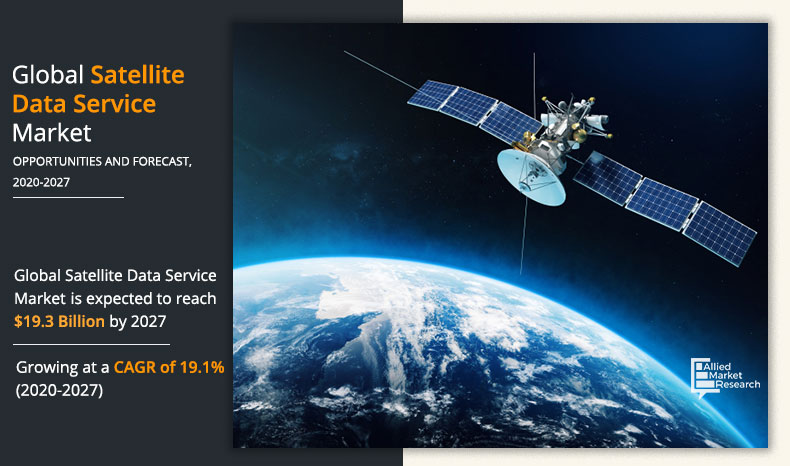According to Allied Market Research, the global satellite data services market was valued at US$ 5.52 billion, growing at a CAGR of around 19.1% during the forecast period (2020-2027). Satellite data is the process of collecting information about earth through manmade satellites traveling around the earth’s orbit. The most common use ofsatellite data is earth observation.
Satellites deliver information about the earth’s surface and weather changes. Satellite data services play an important role in scientific understanding of environmental processes such as carbon capture, albedo change, among others. This information is crucial to manage and safeguard environmental resources.
Moreover, satellite data services are used for various applications such as agriculture, maritime, defense & security, automotive & transportation, among others. Satellite data is useful for characterizing and monitoring terrestrial and surface features such as forest, desserts, and urban cities.
Satellite Data Services Industry Dynamics
The demand for satellite data services is increasing significantly, owing to increasing interest from the private sector toward the space industry. Private sector companies are changing government-developed technologies into affordable and lucrative technologies for commercial end-use. For instance, in June 2020, SpaceX launched 58 Starlink satellites and 3 small Earth-observation satellites. These 3 satellites and 12 other satellites are expected to provide views of earth’s surface that are consistently covered in sunlight. Moreover, in June 2020, Hong Kong Aerospace Technology Group (HKATG) signed a strategic partnership agreement with China Great Wall Industry Corporation (CGWIC). The cooperation includes joint development of the Golden Bauhinia constellation system design, R&D, satellite design, testing, launch, and in-orbit delivery. Such increasing participation of private players in satellite launches and increase in the number of satellites in the earth’s orbit enable satellite data and imagery service providers to provide their solutions for commercial purposes. For instance, in 2018, more than 90 satellites were launched for commercial purposes by the U.S., Italy, China, Japan, and the UK. These satellites are mostly used for mapping, monitoring, and collecting of terrestrial data, which can be used by end-users as per their requirements. However, COVID-19 has impacted the investments coming from private companies.
 Stringent government regulations are a major challenge for the growth of the satellite data services market. Legal issues pertaining to the restrictions on data collection, location privacy, intellectual property rights, use & storage of geospatial information & data, among others limit the scope of the satellite data services market. Players and vendors in satellite launch and remote sensing satellites require regulatory approval from agencies such as Federal Communication Commission (FCC), National Oceanic and Atmospheric Administration (NOAA), and Federal Aviation Administration (FAA). Therefore, it is critical for vendors of satellite imagery analytics solutions to consider such legal matters during the execution of various customer projects. Moreover, governments of various countries across the globe have formulated and implemented regulations to limit the use of satellite imagery to ensure national security. Formulation and implementation of such regulations are expected to highly restrain the growth of the satellite data services market. The integration of 4D GIS software with satellite data presents new pathways in the industry, which are expected to provide opportunities for the growth of the global market.
Stringent government regulations are a major challenge for the growth of the satellite data services market. Legal issues pertaining to the restrictions on data collection, location privacy, intellectual property rights, use & storage of geospatial information & data, among others limit the scope of the satellite data services market. Players and vendors in satellite launch and remote sensing satellites require regulatory approval from agencies such as Federal Communication Commission (FCC), National Oceanic and Atmospheric Administration (NOAA), and Federal Aviation Administration (FAA). Therefore, it is critical for vendors of satellite imagery analytics solutions to consider such legal matters during the execution of various customer projects. Moreover, governments of various countries across the globe have formulated and implemented regulations to limit the use of satellite imagery to ensure national security. Formulation and implementation of such regulations are expected to highly restrain the growth of the satellite data services market. The integration of 4D GIS software with satellite data presents new pathways in the industry, which are expected to provide opportunities for the growth of the global market.
Trends in Satellite Data Services
Artificial intelligence is disrupting the earth observatory sector. AI plays a crucial role in the satellite data service market and effectively leverages key companies to allow systems to derive insight and make decision from raw data sets with minimal human involvement. The machine learning algorithm is a powerful tool for analyzing the satellite imagery of any resolution providing accurate insights.
Moreover, better space communication infrastructure is helpful in faster file downloads from satellite databases. Key companies are providing infrastructures as a service by aggregating ground stations enabling the communication for satellite operators. Better onboard cameras and sensors are transforming the earth observatory industry with more refined satellite imagery by improving the spatial resolution and measurement accuracy. Increasing use of hyperspectral and multispectral imaging technologies for collecting data from earth provides gathering of rich and sophisticated information by collecting the full spectrum of light reflected from the earth’s surface. Furthermore, these technologies combine visible and near infrared imaging to extract information.
Adoption of full motion videos, cloud computing for image storage & analysis, and real-time acquisition and processing integrated data systems (RAPIDS) is increasing significantly in the satellite data services market.
COVID-19 Impact on Satellite Data Services
The COVID-19 pandemic has swept the world, with many industries trying to stay afloat. The government and business involved with space are reacting differently to the new situation.
During the COVID-19 crisis, the demand for crisis monitoring, evidence-based cases, and business intelligence increased significantly. In addition, the players in the satellite data services ecosystem actively contributed to the response efforts by providing storage and processing capabilities for modeling & other research needs and studying the impact of COVID-19. Moreover, companies are also providing earth observation imagery for industry intelligence and monitoring of remotely located infrastructure.
Moreover, as countries began going into lockdown earlier this year, satellite images and data were used to access data without having to break social distancing restrictions. For instance, in South Africa, satellite images were used as a tool to identify potential relocation sites for people living in high-density urban slums who were considered particularly at risk for contracting the coronavirus.
In addtion, the satellite data services and earth observatory sector has witnessed increase in demand for Big Data Analytics (BDA) services from public entities, logistics companies, large retail companies, and business intelligence for determining the COVID-19 situation across countries. The earth observation satellite fleet operating companies Maxar and Planet have witnessed increase in demand for the data they collect to help track global and regional trends in human and natural activity.
In addition, the increasing demand to showcase imagery and outputs of imagery-based applications related to the impact of COVID-19 on the global economy from the news media industry has created a positive impact on the satellite data services market. However, the demand for satellite data services from other sectors, such as financial services and energy, has negatively impacted as the price of oil and stock market collapsed in Q1 - Q2 2020. From supply point, the manufacturing of satellite components got significantly disrupted. In addition, lockdown imposed by various governments also affected the supply chain, owing to which some launch providers delayed their satellite launches.
Post COVID-19 Scenario of Satellite Data Services
The current impact of the COVID-19 outbreak in the satellite manufacturing industry is limited to delays in delivery due to activity slow-downs for some of the manufacturers. According to Allied Market Reports Analysis, satellite launches are expected to witness a drop in 2020 and 2021, owing to delay in the production and supply of launch vehicle components due to the COVID-19 outbreak. Delays in satellite manufacturing activities and satellite launches are anticipated to impact the supply of imagery and analysis services. However, the number is expected to increase by 2022 and beyond, owing to growing demand as well as the need to clear backlogs. Attributed to the COVID-19 pandemic, small & medium-sized companies in the satellite data industry may face liquidity challenges in the short term and may struggle to survive without support from their investors. According to a survey by the Korea Association for Space Technology Promotion, 66% of space companies surveyed in March anticipated negative impacts throughout 2020 while 42% of companies are expecting to recover business in the first half of 2021. Moreover, according to the United State Department of Commerce’s study on the space industrial base, in the U.S., around 90% of space firms with R&D as a primary business line were small businesses. These SMEs are mostly sole source providers of critical equipment, parts, and services. The negative impact of the pandemic on the business of these SMEs may create major challenges in the near future.
With the pandemic, the demand for earth observation and satellite data for pandemic response has increased. However, the COVID-19 outbreak has forced governments across the globe to focus on medical services. The countries are reducing their space budgets to help pay for the pandemic response and recovery measures. Attributed to this fact, large-scale programs offering funds and support to earth observation downstream organizations for research in Europe and the U.S. are expected to have their budget negatively impacted for a short term.
For more information visit at https://www.alliedmarketresearch.com/satellite-data-services-market-A06428
--------------------
 Mayank Halmare is a seasoned market research and consulting professional. He has experience of working on various successful consultation projects with well-known brands in Aerospace and Defense industry such as Sierra Nevada Corporation, Airbus, Planet Labs Inc., and others. His expertise has helped clients across the globe to formulate successful business strategies which contributes significantly in growth of the company. He holds a bachelor’s degree in Mechanical engineering and Master’s degree in MBA from one of the topmost educational institute. He can be reached at: mayank.halmare@alliedanalytics.com
Mayank Halmare is a seasoned market research and consulting professional. He has experience of working on various successful consultation projects with well-known brands in Aerospace and Defense industry such as Sierra Nevada Corporation, Airbus, Planet Labs Inc., and others. His expertise has helped clients across the globe to formulate successful business strategies which contributes significantly in growth of the company. He holds a bachelor’s degree in Mechanical engineering and Master’s degree in MBA from one of the topmost educational institute. He can be reached at: mayank.halmare@alliedanalytics.com





